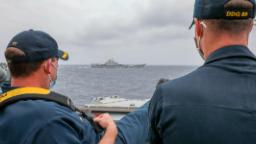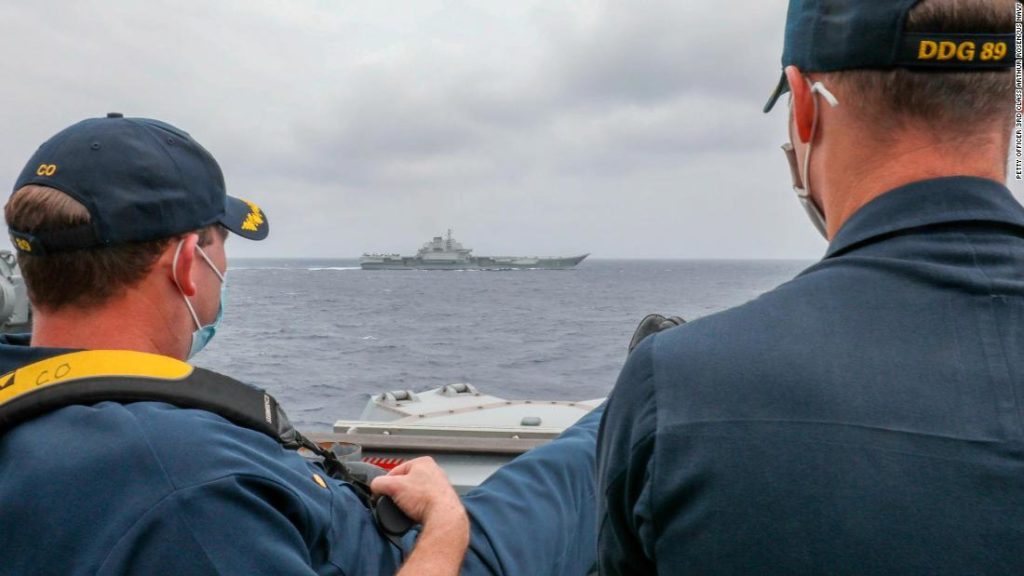
Meanwhile, the US and Philippines were preparing for joint drills as the US secretary of defense proposed ways to deepen military cooperation between Washington and Manila after China massed vessels in disputed waters.
The Liaoning’s reported arrival in the South China Sea came after a US Navy expeditionary strike group, fronted by the aircraft carrier USS Theodore Roosevelt and amphibious assault ship USS Makin Island, conducted exercises in the South China Sea a day earlier. The two flat-top warships were joined by a cruiser, destroyers and smaller amphibious ships.
The ships also carried hundreds of Marine ground forces from the 15th Marine Expeditionary Unit as well as their supporting helicopters and F-35 fighter jets.
“This expeditionary strike force fully demonstrates that we maintain a combat-credible force, capable of responding to any contingency, deter aggression, and provide regional security and stability in support of a free and open Indo-Pacific,” US Navy Capt. Stewart Bateshansky, commodore, Amphibious Squadron 3, said in a statement.
Global Times quoted a Chinese military expert, Wei Dongxu, as saying the US Navy exercises were a provocation.
Exercises by the Chinese carrier “can establish wider maritime defensive positions, safeguard China’s coastal regions, and keep US military activities in check,” the report said, citing Wei.
But a US analyst described the Liaoning’s presence in the South China Sea as normal for the spring when weather conditions are conducive to training. “The Liaoning goes down there this time of year (to practice) air defense and live-fire training,” said Carl Schuster, a former director of operations at the US Pacific Command’s Joint Intelligence Center.
US-Philippines joint exercises
The drills will focus on testing the readiness of US and Philippine troops to respond to events such as extremist attacks and natural disasters, the report said.
They come after US Defense Secretary Lloyd Austin on Sunday proposed to his counterpart in Manila, Delfin Lorenzana, ways to deepen ties between the US and Philippine militaries, a Pentagon statement said.
Washington and Manila are tied by a mutual defense treaty, which officials said could come into play in the event of any Chinese military action against Philippine government vessels around Whitsun Reef.
Locsin’s comments came after a Filipino news crew said last week their chartered boat was chased down by Chinese missile boats as it approached a disputed shoal in the Spratly chain, according to the CNN Philippines report.
China claims almost all of the 1.3 million square mile South China Sea as its sovereign territory, running up against claims from the Philippines and other nations. In recent years, Beijing has turned disputed features in the region into man-made islands, complete with military fortifications.
Beijing accuses Washington and other foreign navies of stoking tensions in the region by sending in warships like the current expeditionary group led by the carrier Roosevelt.
Taiwan tensions
Tensions extend to the northeastern edges of the South China Sea, where the island of Taiwan sits. Beijing claims the democratic, self-governed island of almost 24 million people as its territory, even though the two sides have been governed separately for more than seven decades.
Chinese President Xi Jinping has vowed that Beijing will never allow Taiwan to become formally independent and has refused to rule out the use of force, if necessary, to unify the island with the mainland.
Analysts said the exercises were a warning to Taipei and Washington that Beijing would not brook any moves for Taiwanese independence and was prepared to act militarily to prevent that from happening.
US Secretary of State Antony Blinken on Sunday said Washington was standing by a commitment to defend Taiwan.
“What is a real concern to us is increasingly aggressive actions by the government in Beijing directed at Taiwan,” Blinken said on NBC’s “Meet the Press.”
“We have a serious commitment to Taiwan being able to defend itself. We have a serious commitment to peace and security in the Western Pacific. And in that context, it would be a serious mistake for anyone to try to change that status quo by force,” Blinken said.
You may also like
-
Afghanistan: Civilian casualties hit record high amid US withdrawal, UN says
-
How Taiwan is trying to defend against a cyber ‘World War III’
-
Pandemic travel news this week: Quarantine escapes and airplane disguises
-
Why would anyone trust Brexit Britain again?
-
Black fungus: A second crisis is killing survivors of India’s worst Covid wave

